Energy-Efficient Optimal Power Allocation in Integrated Wireless Sensor and Cognitive Satellite Terrestrial Networks
Abstract
:1. Introduction
2. System Model
3. Energy-Efficient Optimal Power Allocation
3.1. Energy-Efficient Optimal Power Allocation for Non-Real-Time Applications
3.1.1. Average Transmit Power Constraint
| Algorithm 1: Iterative Power Allocation Algorithm for (8). |
| Set parameters: , , : Error tolerances; , : Step sizes; : Iteration number. Initialization: , , , ; Calculate using (14); , . Search optimal values: , ; While ; Update and by subgradient method as follows: While or ; ; ; Calculate using (14); ; ; End; ; ; End; ; . |
3.1.2. Peak Transmit Power Constraint
3.2. Energy-Efficient Optimal Power Allocation for Real-Time Applications
3.2.1. Average Transmit Power Constraint
3.2.2. Peak Transmit Power Constraint
4. Simulation Results and Analysis
4.1. Non-Real-Time Applications
4.2. Real-Time Applications
5. Conclusions
Acknowledgments
Author Contributions
Conflicts of Interest
References
- Akyldiz, I.; Su, W.; Sankarasubramaniam, Y.; Cayirci, E. A survey on sensor networks. IEEE Commun. Mag. 2002, 40, 102–114. [Google Scholar] [CrossRef]
- Li, H.; Hao, Y.; Gong, X.; Dong, F.; Ren, B.; He, Y.; Wang, J. Performance Analysis of Integrated Wireless Sensor and Multibeam Satellite Networks Under Terrestrial Interference. Sensors 2016, 16, 1–22. [Google Scholar] [CrossRef] [PubMed]
- Aulov, O.; Halem, M. Human sensor networks for improved modeling of natural disasters. Proc. IEEE 2012, 100, 2812–2823. [Google Scholar] [CrossRef]
- Astapov, S.; Preden, J.; Ehala, J.; Riid, A. Object detection for military surveillance using distributed multimodal smart sensors. In Proceedings of the 19th International Conference on Digital Signal Processing (DSP’14), Hong Kong, China, 20–23 August 2014; pp. 366–371. [Google Scholar]
- Zheng, G.; Chatzinotas, S.; Ottersten, B. Generic optimization of linear precoding in multibeam satellite systems. IEEE Trans. Wirel. Commun. 2012, 11, 2308–2320. [Google Scholar] [CrossRef]
- An, K.; Lin, M.; Liang, T.; Wang, J.; Wang, J.; Huang, Y.; Swindlehurst, A.L. Performance analysis of multi-antenna hybrid satellite-terrestrial relay networks in the presence of interference. IEEE Trans. Commun. 2015, 63, 4390–4404. [Google Scholar] [CrossRef]
- Bisio, I.; Marchese, M. Satellite earth station (SES) selection method for satellite-based sensor networks. Electron. Lett. 2007, 11, 970–973. [Google Scholar] [CrossRef]
- Dong, F.; Li, M.; Gong, X.; Li, H.; Gao, F. Diversity performance analysis on multiple HAP networks. Sensors 2015, 15, 15398–15418. [Google Scholar] [CrossRef] [PubMed]
- Wang, W.; Jiang, D. Integrated wireless sensor systems via near-space and satellite platforms: A review. IEEE Sens. J. 2014, 14, 3903–3914. [Google Scholar] [CrossRef]
- Sharma, S.K.; Chatzinotas, S.; Ottersten, B. Cognitive radio techniques for satellite communication systems. In Proceedings of the IEEE 78th Vehicular Technology Conference (VTC Fall), Las Vegas, NV, USA, 2–5 September 2013; pp. 1–5. [Google Scholar]
- An, K.; Lin, M.; Ouyang, J.; Zhu, W. Secure transmission in cognitive satellite terrestrial networks. IEEE J. Sel. Areas Commun. 2016, 34, 3025–3037. [Google Scholar] [CrossRef]
- An, K.; Lin, M.; Zhu, W.-P.; Huang, Y.; Zheng, G. Outage performance of cognitive hybrid satellite-terrestrial networks with interference constraint. IEEE Trans. Veh. Technol. 2016, 65, 9397–9404. [Google Scholar] [CrossRef]
- Haykin, S. Cognitive radio: Brain-empowered wireless communications. IEEE J. Sel. Areas Commun. 2005, 23, 201–220. [Google Scholar] [CrossRef]
- Liolis, K.; Schlueter, G.; Krause, J.; Zimmer, F.; Combelles, L.; Grotz, J.; Chatzinotas, S.; Evans, B.; Guidotti, A.; Tarchi, D. Cognitive radio scenarios for satellite communications: The CoRaSat approach. In Proceedings of the Future Network and Mobile Summit (FutureNetworkSummit), Lisbon, Portugal, 3–5 July 2013; pp. 1–10. [Google Scholar]
- Lagunas, E.; Maleki, S.; Chatzinotas, S.; Soltanalian, M.; Perez-Neira, A.I.; Ottersten, B. Power and rate allocation in cognitive satellite uplink networks. In Proceedings of the IEEE International Conference on Communications (ICC), Kuala Lumpur, Malaysia, 23–27 May 2016; pp. 1–6. [Google Scholar]
- Vassaki, S.; Poulakis, M.I.; Panagopoulos, A.D. Optimal iSINR-based power control for cognitive satellite terrestrial networks. Trans. Emerging Ttelecommun. Technol. 2017, 28, 1–10. [Google Scholar] [CrossRef]
- Shi, S.; Li, G.; An, K.; Li, Z.; Zheng, G. Optimal power control for real-time applications in cognitive satellite terrestrial networks. IEEE Commun. Lett. 2017, 21, 1815–1818. [Google Scholar] [CrossRef]
- Feng, D.; Jiang, C.; Lim, G.; Cimini, L.J.; Feng, G.; Li, G.Y. A survey of energy-efficient wireless communications. IEEE Commun. Surv. Tutor. 2013, 15, 167–178. [Google Scholar] [CrossRef]
- Jiang, C.; Zhang, H.; Ren, Y.; Chen, H. Energy-efficient noncooperative cognitive radio networks: Micro, meso, and macro views. IEEE Commun. Mag. 2014, 52, 14–20. [Google Scholar] [CrossRef]
- Chen, Y.; Zhang, S.; Xu, S.; Li, G. Fundamental trade-offs on green wireless networks. IEEE Commun. Mag. 2011, 49, 30–37. [Google Scholar] [CrossRef]
- Alagoz, F.; Gur, G. Energy efficiency and satellite networking: A holistic overview. Proc. IEEE. 2011, 99, 1954–1979. [Google Scholar] [CrossRef]
- Fu, A.C.; Modiano, E.; Tsitsiklis, J.N. Optimal energy allocation and admission control for communications satellites. IEEE/ACM Trans. Netw. 2003, 11, 488–500. [Google Scholar] [CrossRef]
- Qi, T.; Wang, Y. Energy-efficient power allocation over multibeam satellite downlinks with imperfect CSI. In Proceedings of the WCSP, Nanjing, China, 15–17 October 2015; pp. 1–5. [Google Scholar]
- Zhang, J.; Evans, B.; Imran, M.A.; Zhang, X.; Wang, W. Green hybrid satellite terrestrial networks: Fundamental trade-off analysis. In Proceedings of the 2016 IEEE 83rd Vehicular Technology Conference (VTC Spring), Nanjing, China, 15–18 May 2016; pp. 1–5. [Google Scholar]
- Chatzinotas, S.; Zheng, G.; Ottersten, B. Energy-efficient MMSE beamforming and power allocation in multibeam satellite systems. In Proceedings of the 2011 Conference Record of the Forty Fifth Asilomar Conference on Signals, Systems and Computers (ASILOMAR), Pacific Grove, CA, USA, 6–9 November 2011; pp. 1081–1085. [Google Scholar]
- Dinkelbach, W. On nonlinear fractional programming. Manag. Sci. 1967, 13, 492–498. [Google Scholar] [CrossRef]
- Boyd, S.P.; Vandenberghe, L. Convex Optimization; Cambridge University Press: Cambridge, UK, 2004. [Google Scholar]
- Sharma, S.K.; Chatzinotas, S.; Ottersten, B. Satellite cognitive communications: Interference modeling and techniques selection. In Proceedings of the 6th Advanced Satellite Multimedia Systems Conference (ASMS) and 12th Signal Processing for Space Communications Workshop (SPSC), Baiona, Spain, 5–7 September 2012; pp. 111–118. [Google Scholar]
- Khan, A.W.; Abdullah, A.H.; Anisi, M.H.; Javed, I.B. A comprehensive study of data collection schemes using mobile sinks in wireless sensor networks. Sensors 2014, 14, 2510–2548. [Google Scholar] [CrossRef] [PubMed]
- Chakrabarti, A.; Sabharwal, A.; Aazhang, B. Using Predictable Observer Mobility for Power Efficient Design of Sensor Networks. In Proceedings of the the Information Processing in Sensor Networks, (IPSN’03), Palo Alto, CA, USA, 22–23 April 2003; pp. 129–145. [Google Scholar]
- Shah, R.C.; Roy, S.; Jain, S.; Brunette, W. Data mules: Modeling a three-tier architecture for sparse sensor networks. Ad Hoc Netw. 2003, 1, 215–233. [Google Scholar] [CrossRef]
- Gandham, S.R.; Dawande, M.; Prakash, R.; Venkatesan, S. Energy Efficient Schemes for Wireless Sensor Networks with Multiple Mobile Base Stations. In Proceedings of the IEEE Global Telecommunications Conference 2003 (GLOBECOM’03), San Francisco, CA, USA, 1–5 December 2003; Volume 1, pp. 377–381. [Google Scholar]
- Yu, F.; Park, S.; Lee, E.; Kim, S.H. Elastic routing: A novel geographic routing for mobile sinks in wireless sensor networks. IET Commun. 2010, 4, 716–727. [Google Scholar] [CrossRef]
- Abdi, A.; Lau, W.C.; Alouini, M.S.; Kaveh, M. A new simple model for land mobile satellite channels: First- and second-order statistics. IEEE Trans. Wirel. Commun. 2003, 2, 519–528. [Google Scholar] [CrossRef]
- Gradshteyn, I.S.; Ryzhik, I.M. Table of Integrals, Series, and Products, 7th ed.; Elsevier: San Diego, CA, USA, 2007. [Google Scholar]
- Maleki, S.; Chatzinotas, S.; Krause, J.; Liolis, K.; Ottersten, B. Cognitive zone for broadband satellite communications in 17.3–17.7 GHz band. IEEE Wirel. Commun. Lett. 2015, 4, 305–308. [Google Scholar] [CrossRef]
- Wang, L.; Sheng, M.; Wang, X.; Zhang, Y.; Ma, X. Mean energy efficiency maximization in cognitive radio channels with PU outage constraint. IEEE Commun. Lett. 2015, 19, 287–290. [Google Scholar] [CrossRef]
- Zhang, R. On peak versus average interference power constraints for protecting primary users in cognitive radio networks. IEEE Trans. Wirel. Commun. 2009, 8, 1128–1138. [Google Scholar] [CrossRef]
- Alabbasi, A.; Rezki, Z.; Shihada, B. Energy efficient resource allocation for cognitive radios: A generalized sensing analysis. IEEE Trans. Wirel. Commun. 2015, 14, 2455–2469. [Google Scholar] [CrossRef]
- Schaible, S. Fractional programming. II, Dinkelbach’s algorithm. Manag. Sci. 1976, 22, 868–873. [Google Scholar] [CrossRef]

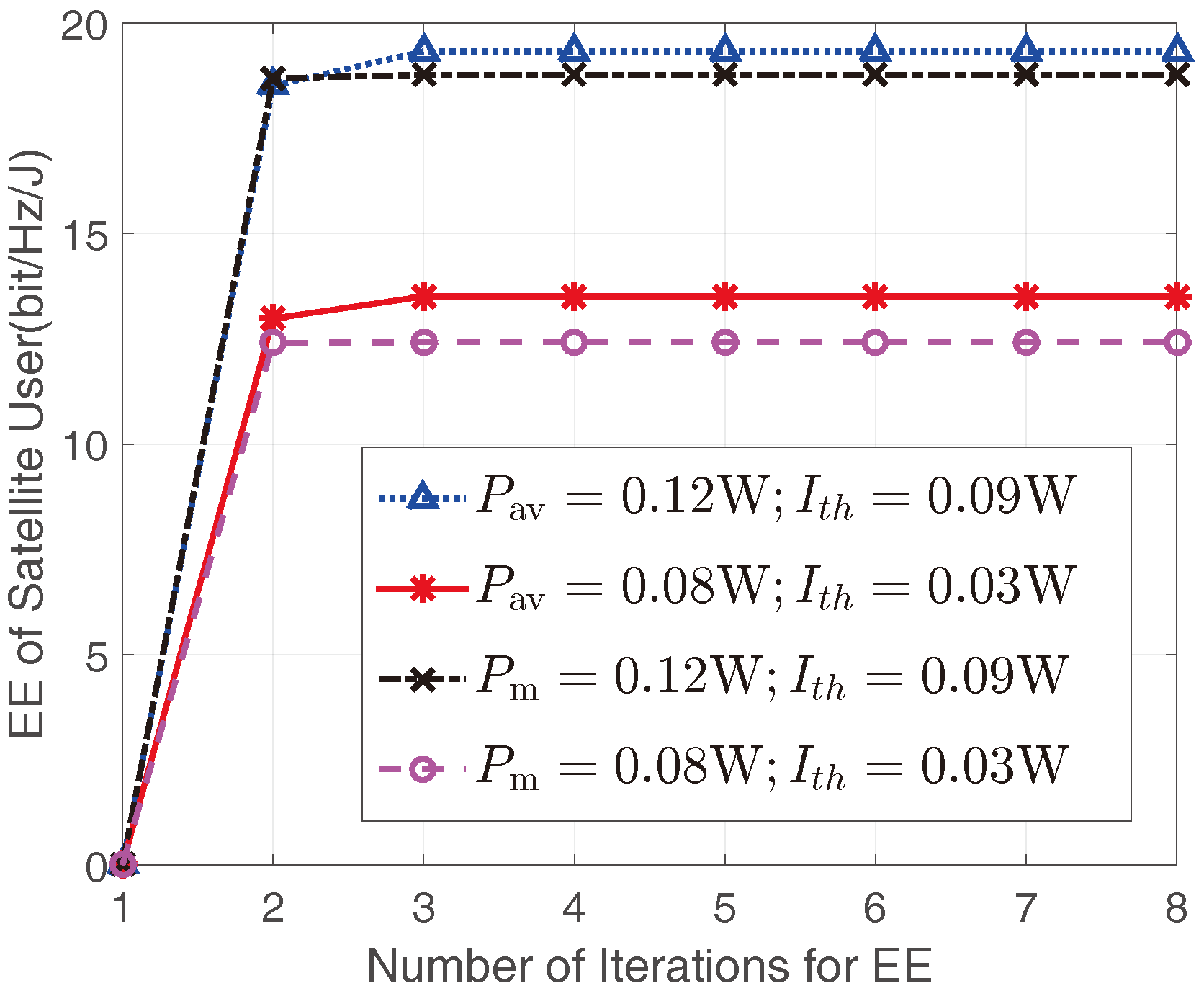
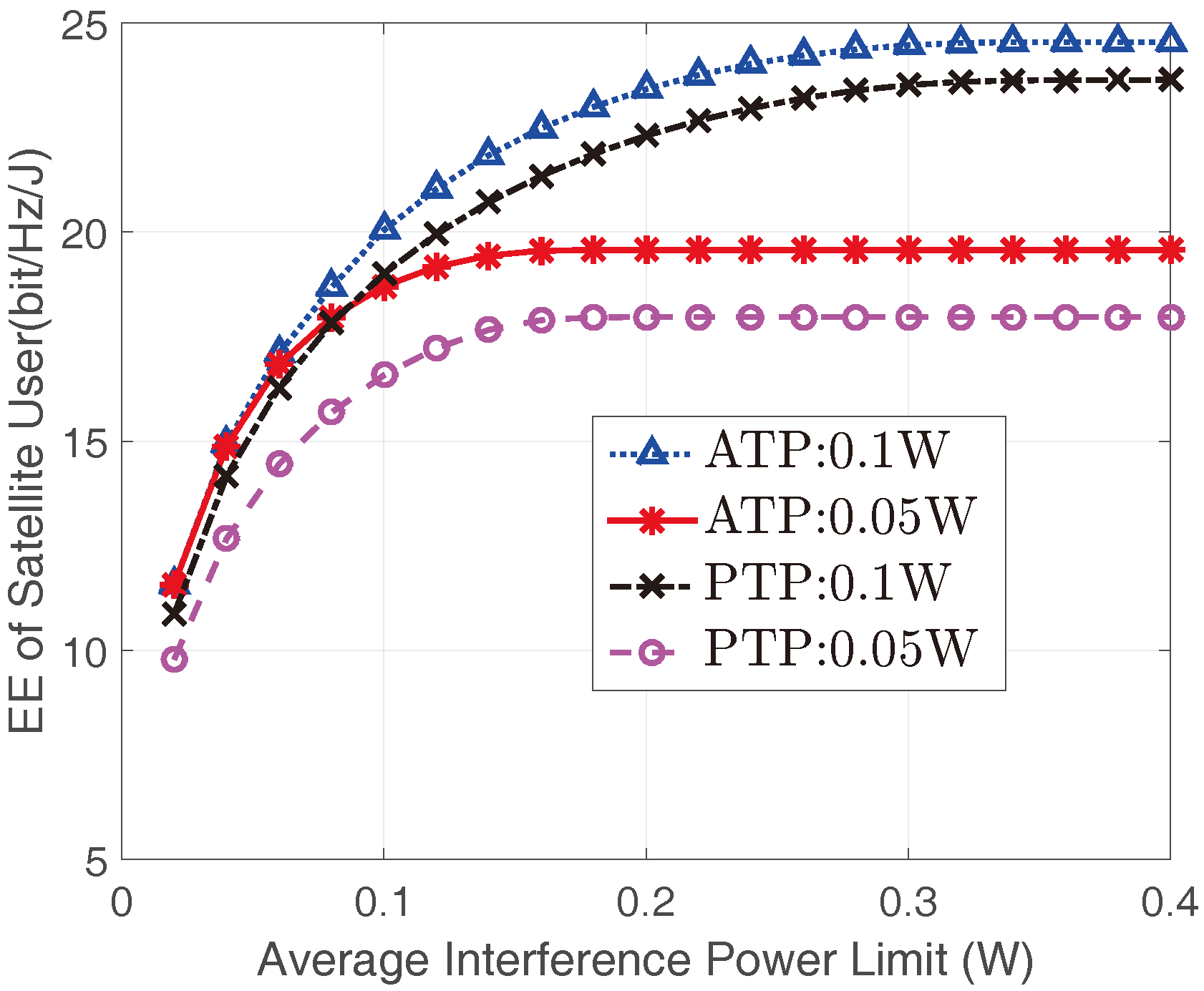
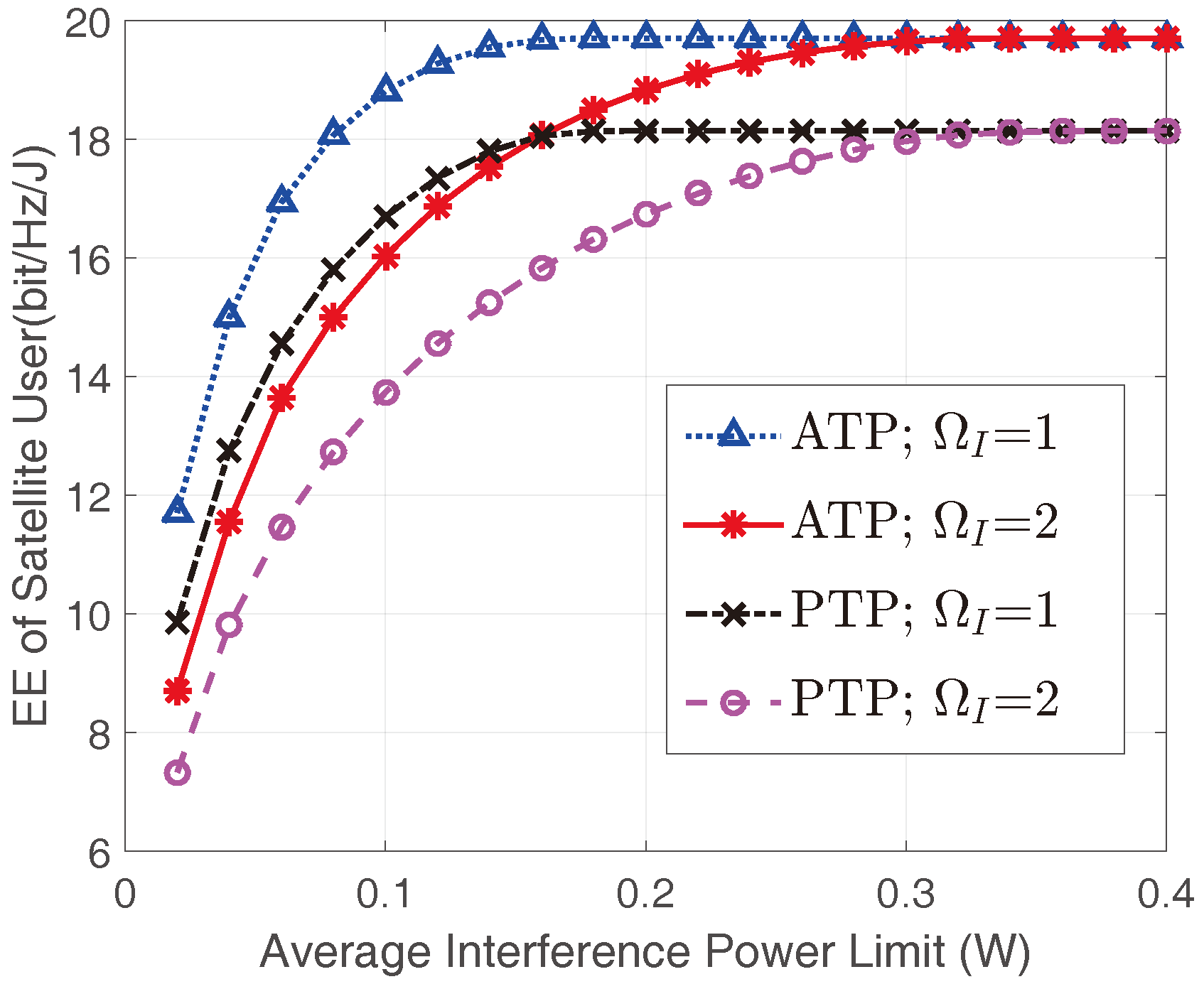
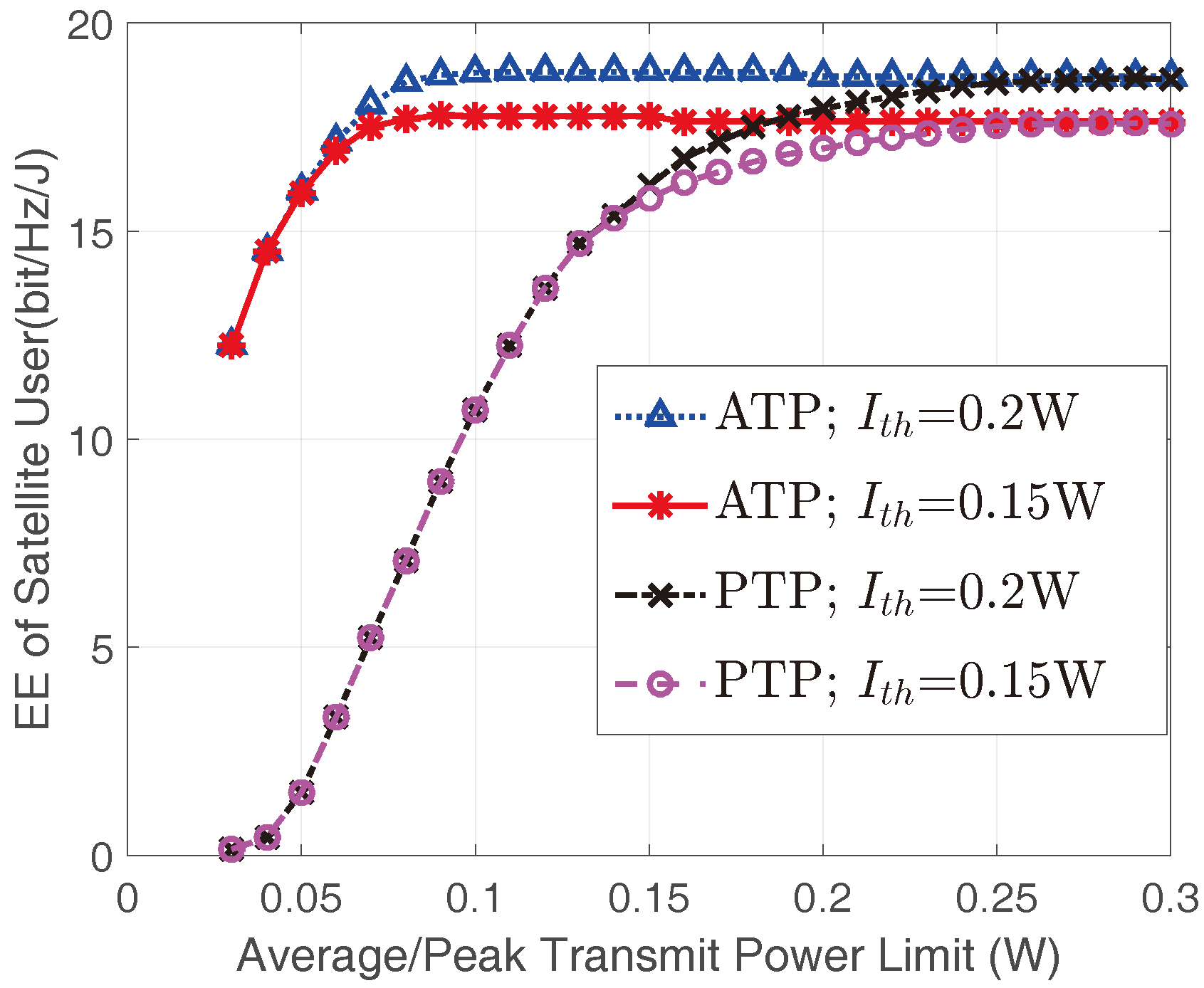
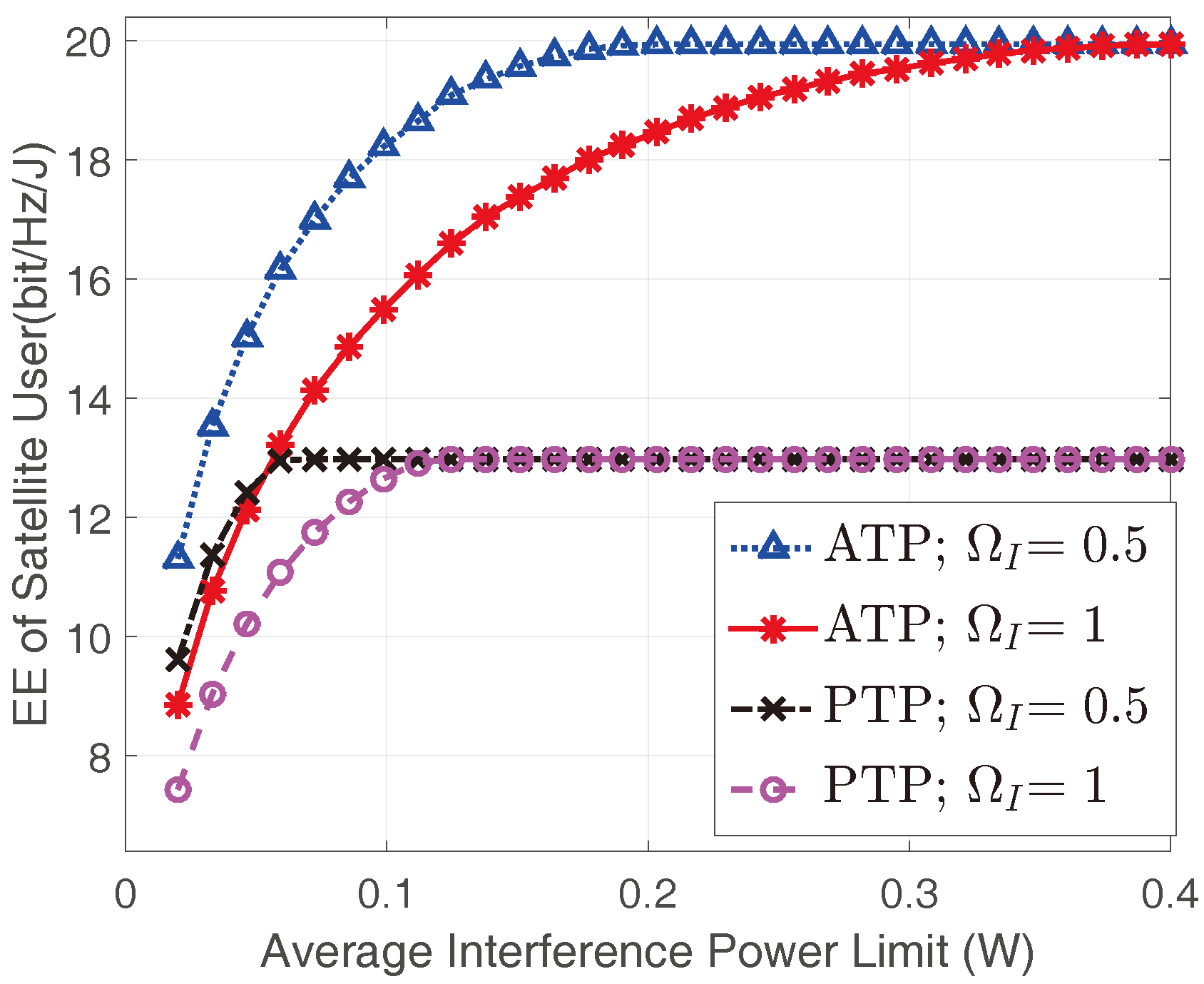
| Parameters | Values |
|---|---|
| signal frequency (f) | 2 GHz |
| 42.1 dB | |
| 52.1 dB | |
| 0 dB | |
| 0.01 W | |
| 0.2 | |
| 0.05 W | |
| 2 bit/s/Hz | |
| satellite link distance () | 35,786 km |
| interference link distance () | 10 km |
| , | 0.1 |
| , , | |
| 10 | |
| 0.835 | |
| 0.126 |
© 2017 by the authors. Licensee MDPI, Basel, Switzerland. This article is an open access article distributed under the terms and conditions of the Creative Commons Attribution (CC BY) license (http://creativecommons.org/licenses/by/4.0/).
Share and Cite
Shi, S.; Li, G.; An, K.; Gao, B.; Zheng, G. Energy-Efficient Optimal Power Allocation in Integrated Wireless Sensor and Cognitive Satellite Terrestrial Networks. Sensors 2017, 17, 2025. https://doi.org/10.3390/s17092025
Shi S, Li G, An K, Gao B, Zheng G. Energy-Efficient Optimal Power Allocation in Integrated Wireless Sensor and Cognitive Satellite Terrestrial Networks. Sensors. 2017; 17(9):2025. https://doi.org/10.3390/s17092025
Chicago/Turabian StyleShi, Shengchao, Guangxia Li, Kang An, Bin Gao, and Gan Zheng. 2017. "Energy-Efficient Optimal Power Allocation in Integrated Wireless Sensor and Cognitive Satellite Terrestrial Networks" Sensors 17, no. 9: 2025. https://doi.org/10.3390/s17092025
APA StyleShi, S., Li, G., An, K., Gao, B., & Zheng, G. (2017). Energy-Efficient Optimal Power Allocation in Integrated Wireless Sensor and Cognitive Satellite Terrestrial Networks. Sensors, 17(9), 2025. https://doi.org/10.3390/s17092025





